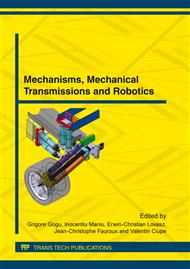[1]
Das, A. K., R. Fierro, V. Kumar, J. P. Ostrowski, J. Spletzer and C. J. Taylor, A vision-based formation control framework, IEEE Transactions on Robotics and Automation, 18 (2002), p.813–825.
DOI: 10.1109/tra.2002.803463
Google Scholar
[2]
Vidal, R., O. Shakernia and S. Sastry, Following the flock: distributed formation control with omnidirectional vision-based motion segmentation and visual servoing, IEEE Robotics and Automation Magazine, 11 (2004), p.14–20.
DOI: 10.1109/robot.2003.1241657
Google Scholar
[3]
Lopez-Nicolas, G., J. J. Guerrero and C. Sagues, Visual control of vehicles using two-view geometry, Mechatronics, 20 (2010), p.315–325.
DOI: 10.1016/j.mechatronics.2010.01.005
Google Scholar
[4]
Spong, M. W., S. Hutchinson and M. Vidyasagar, Robot Dynamics and Control, self-published, 2nd ed., 2004. First edition published by John Wiley and Sons, Inc. in (1989).
Google Scholar
[5]
Pitteway, M. L. V., Algorithm for drawing ellipses or hyperbolae with a digital plotter, Computer Journal, 10 (1967), p.282–289.
DOI: 10.1093/comjnl/10.3.282
Google Scholar
[6]
Smith, L. B., Drawing ellipses, hyperbolas or parabolas with a fixed number of points and maximum inscribed area, Computer Journal, 14 (1971), p.81–86.
DOI: 10.1093/comjnl/14.1.81
Google Scholar
[7]
Plummer, H. C., An introductory treatise on dynamical astronomy, Dover Publications, Inc., New York, 1960. Republication of 1918 CUP manuscript.
Google Scholar
[8]
Halir, R. and J. Flusser, Numerically stable direct least-squares fitting of ellipses, in Proceedings of the 6th International Conference in Central Europe on Computer Graphics and Visualisation, (1998).
Google Scholar
[9]
O'Leary, P. and P. Zsombor-Murray, Direct and specific least-square fitting of hyperbolae and ellipses, Journal of Electronic Imaging, 13 (2004), p.482–503.
DOI: 10.1117/1.1758951
Google Scholar
[10]
Gauss, K. F., Theory of the Motion of the Heavenly Bodies Moving About the Sun in Conic Sections, Dover, 1963. Reprint of 1857 translation of 1809 original Theoria motus corporum coelestium in sectionibus conicis solem ambientum.
DOI: 10.1017/cbo9780511841705.001
Google Scholar
[11]
Dennis, J. E. Jr. and R. E. Schnabel. Numerical Methods for Unconstrained Optimization and Nonlinear Equations, Prentice-Hall Series in Computational Mathematics, Prentice-Hall, Toronto, (1983).
Google Scholar
[12]
Fitzgibbon, A., M. Pilu and R. B. Fisher, Direct least square fitting of ellipses, IEEE Transactions on Pattern Analysis and Machine Intelligence, 21 (1999), p.476–480.
DOI: 10.1109/34.765658
Google Scholar


